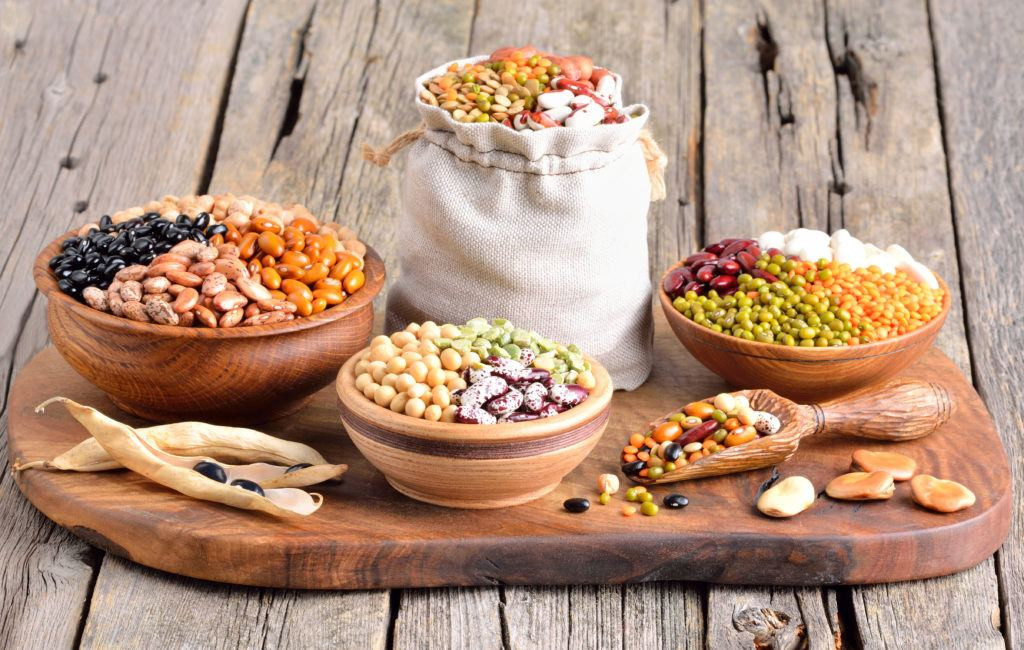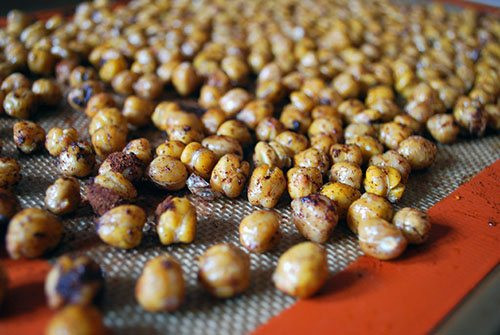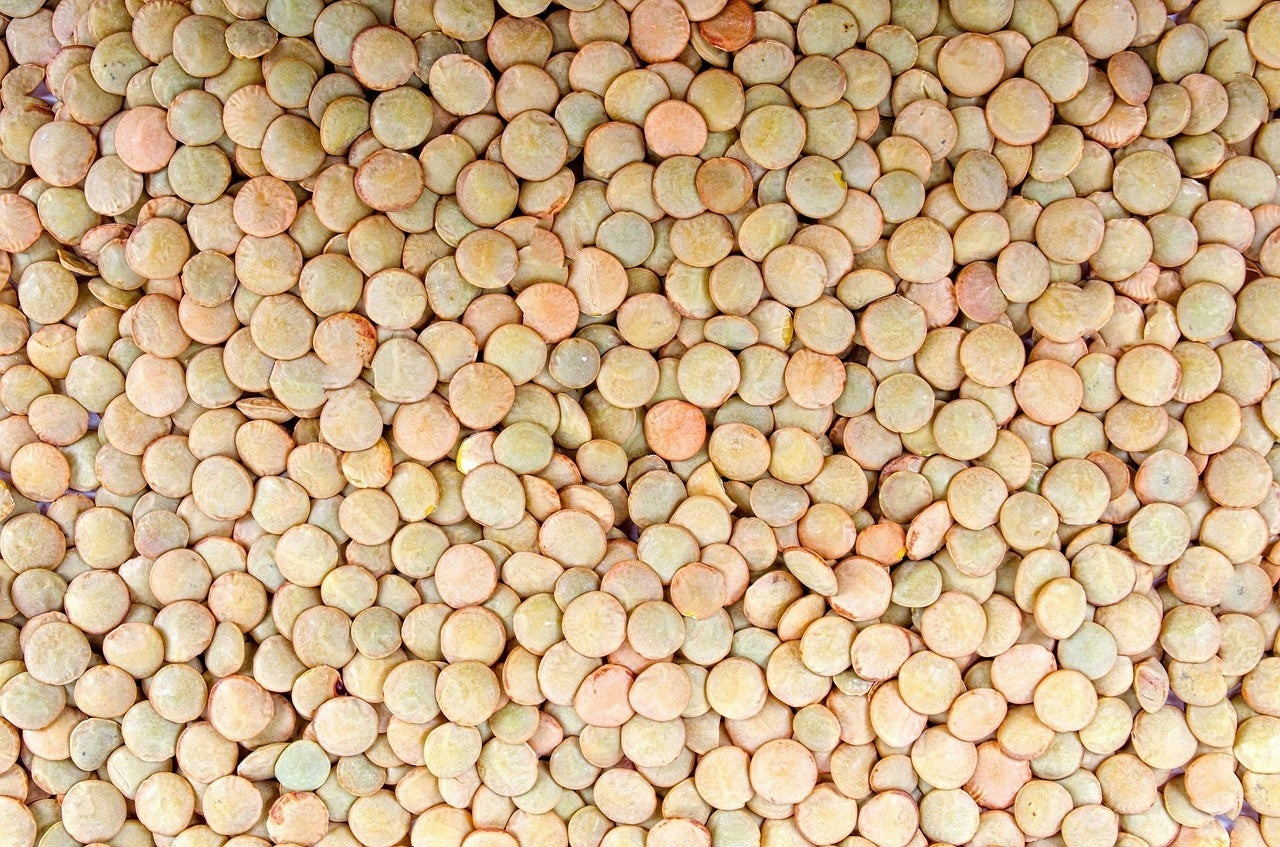 A variety of legumes and pulses organized in bags and bowls on a wooden tray, including black beans, cranberry beans, kidney beans, white beans, split peas, mung beans, yellow lentils, red lentils, green lentils
A variety of legumes and pulses organized in bags and bowls on a wooden tray, including black beans, cranberry beans, kidney beans, white beans, split peas, mung beans, yellow lentils, red lentils, green lentils
The Fabaceae, also known as Leguminosae, family, commonly referred to as the legume, pea, or bean family, stands as the third largest family of flowering plants on our planet. Boasting over 20,000 diverse species, this plant family offers a significant contribution to global diets and ecosystems alike. [1] Legumes, the nutritious seeds from this expansive family, are dietary staples across cultures, revered for their affordability and rich profiles of protein, essential vitamins, complex carbohydrates, and dietary fiber.
While the terms “legumes,” “pulses,” and “beans” are often used interchangeably in casual conversation, they possess distinct botanical and culinary meanings. A legume technically refers to any plant belonging to the Fabaceae family in its entirety, encompassing the leaves, stems, and pods. In contrast, a pulse is the term designated for the edible seed harvested from a legume plant. This category of pulses includes familiar foods like beans, lentils, and peas. To illustrate, a pea pod itself is a legume, while the peas nestled within are the pulses. The entire legume plant often finds applications in agriculture, serving as cover crops, livestock feed, or natural fertilizers, whereas the seeds, or pulses, are what we primarily consume as part of our diets. Beans, encompassing varieties such as kidney, black, pinto, navy, and chickpeas, represent just one diverse type within the broader pulse category.
Recognizing their nutritional importance, health organizations worldwide advocate for the consumption of legumes. The U.S. Dietary Guidelines recommend approximately 3 cups of legumes per week, and the DASH (Dietary Approaches to Stop Hypertension) Eating Plan from the National Heart, Lung, and Blood Institute suggests 4-5 half-cup servings weekly. [2] Highlighting their global significance, the Food and Agriculture Organization (FAO) of the United Nations declared 2016 as the International Year of Pulses. This initiative aimed to raise awareness about the crucial role of pulses in enhancing food production and nutritional diversity, particularly in efforts to combat hunger and malnutrition on a global scale. [3]
Legumes: A Powerhouse of Nutrition
Health Benefits of Legumes from the Fabaceae Family
Legumes, as part of a well-rounded, plant-based dietary approach, offer a wealth of components that may play a significant role in preventing the development of various chronic diseases.
Cardiovascular Health and Legumes
Multiple components within legumes contribute to their heart-health promoting properties. These include dietary fiber, folate, and beneficial phytochemicals. In their whole, unprocessed form, legumes are naturally low in saturated fat and sodium. The fiber content in legumes is particularly noteworthy for its potential to lower blood cholesterol levels, even independent of weight changes. Furthermore, this fiber can help regulate blood sugar levels, preventing rapid spikes, both of which are key risk factors for cardiovascular disease. [4]
- Meta-analysis findings: A comprehensive meta-analysis, primarily examining observational studies, revealed that consuming legumes approximately four times per week was associated with a 14% reduction in the risk of coronary artery disease. [4]
- Cholesterol Regulation: Another meta-analysis encompassing 11 clinical trials investigated the impact of pulses on different types of cholesterol, specifically HDL (high-density lipoprotein) and LDL (low-density lipoprotein). The findings indicated that pulse consumption led to a decrease in fasting total cholesterol by about 7% and LDL (“bad”) cholesterol by 6%, while simultaneously increasing HDL (“good”) cholesterol by 2.6%. The researchers attributed these beneficial effects to the soluble fiber, oligosaccharides (a type of carbohydrate), and phytochemicals present in pulses. [5]
- Long-term Heart Health Study: A cohort study tracking 9,632 men and women initially free of cardiovascular disease from the National Health and Nutrition Examination Survey, monitored participants over 19 years. The results showed that individuals who consumed legumes four or more times a week had a 22% lower risk of developing heart disease and an 11% lower risk of experiencing cardiovascular events such as stroke or heart attack compared to those who consumed legumes less than once a week. [6]
- Plant Protein Substitution: A meta-analysis of 36 randomized controlled trials, involving a total of 1,803 participants, explored the effects of substituting plant-based proteins, such as those found in legumes, for red meat. The study demonstrated that this dietary shift reduced key risk factors associated with cardiovascular disease, including blood cholesterol, triglycerides, and blood pressure. [7]
Cancer Prevention and the Role of Legumes
The fiber, phytochemicals, and minerals present in legumes may also exert anti-cancer effects, as suggested by both animal and cell-based studies. For instance, zinc, a nutrient found in legumes, has been linked to improved immune function and reduced oxidative stress within cells. Selenium and phytic acid, also found in legumes, have demonstrated the ability to inhibit tumor growth in mice models. However, evidence from human studies regarding legumes and cancer protection is less conclusive.
Despite the need for more human research, prominent health organizations recognize the potential benefits. The World Cancer Research Fund (WCRF) and the American Institute for Cancer Research, in their comprehensive report, Food, Nutrition and Prevention of Cancer: A Global Perspective, advocate for incorporating pulses into most meals. This recommendation supports their broader guideline of achieving at least 30 grams of dietary fiber daily, as a high-fiber diet has been consistently associated with a reduced risk of certain cancers, particularly colorectal cancer. [8] The WCRF specifically highlights that “foods containing dietary fibre decrease the risk of colorectal cancer,” suggesting that components beyond fiber in high-fiber foods, such as those in legumes, may contribute to cancer prevention, possibly by supporting the production of butyrate, a short-chain fatty acid (further discussed in the “digestive health” section).
Legumes and Digestive Wellness
Legumes are rich sources of fiber, resistant starches, and non-digestible carbohydrates like oligosaccharides, all of which contribute to digestive health. Resistant starch, sometimes referred to as slowly digestible starch, escapes digestion in the small intestine and reaches the colon, where it functions similarly to fiber. It adds bulk to stool and acts as a prebiotic, nourishing beneficial gut bacteria, such as Bifidobacteria. [9] As these bacteria ferment resistant starches and oligosaccharides, they produce gas, which can lead to bloating and abdominal discomfort in some individuals. Soaking dried beans for at least three hours and thoroughly cooking them can help mitigate this side effect. However, in the long term, these beneficial bacteria play a crucial role in maintaining healthy bowel function and may reduce the levels of cancer-causing compounds in the gut. [9] During fermentation, these bacteria also produce butyrate, a short-chain fatty acid that has been linked to the prevention of colorectal cancer. [10]
Diabetes Management and Legumes
Legumes possess characteristics that can be beneficial in diabetes prevention and management. They have a low glycemic index, are high in fiber, and contain slow-digesting resistant starch. Despite these promising components, research findings on the direct impact of legumes on diabetes prevention and blood glucose control have been mixed, and a definitive answer remains elusive. Smaller randomized controlled trials have yielded inconsistent results regarding the benefits of legumes in this area. Large cohort studies have also presented inconclusive findings:
- Study on Older Women in the U.S.: A cohort study involving 35,988 older women in the U.S., initially free of diabetes, followed participants for 6 years. The study found no significant association between bean consumption and diabetes risk when comparing those with the highest bean intake to those with the lowest. [11]
- Study on Middle-aged Women in China: Another cohort study of 64,277 middle-aged women in China without diabetes at the start of the study, followed participants for 4.5 years. This study revealed that women who consumed the most legumes (approximately 1/3 cup daily) had a 38% reduced risk of developing type 2 diabetes compared to those with the lowest legume intake. [12] It is important to note that this study defined legumes broadly, including soybeans and peanuts along with pulses, whereas the U.S. study did not specifically include these.
Weight Management and Legumes
Legumes offer dietary components that can contribute to healthy weight management. Their protein and soluble/insoluble fiber content can enhance feelings of fullness and modestly increase calorie expenditure through thermogenesis, the process of heat production in the body. [2] Only about 40% of the fiber in food is broken down during digestion, which effectively reduces overall calorie intake. [13] Fiber also requires more chewing, slowing down eating pace, and slows down digestion in the stomach, both contributing to increased satiety.
A study analyzing data from 8,229 adults from the National Health and Nutrition Examination Survey found that individuals who consumed beans had a lower body weight and smaller waist circumference compared to those who did not. [13] Bean consumers exhibited a 23% and 22% lower risk of increased waist size and obesity, respectively.
 Falafel on a pita over hummus, yogurt and paprika
Falafel on a pita over hummus, yogurt and paprika
Legume-Based Products: A Growing Market
Due to their versatile texture, flavor profiles, and impressive nutritional composition, legumes are increasingly incorporated into a wide array of food products available in supermarkets. Beyond traditional options like tofu, peanut butter, and hummus, legumes and their components are key ingredients in the burgeoning market of plant-based meat alternatives. As these products involve varying degrees of processing, it is important for consumers to be mindful of potential added sodium, sugar, saturated fats from tropical oils, or other additives. Carefully reviewing the Nutrition Facts label and ingredient list can guide informed decisions when incorporating processed foods, including legume-based products, into a balanced diet.
Legumes: Good for Your Health and the Planet
 Icon of a globe with a fork and spoon on the sides of it
Icon of a globe with a fork and spoon on the sides of it
Food production exerts significant pressure on our planet’s natural resources. Agriculture is a major contributor to climate change, deforestation, species extinction, and the depletion and contamination of freshwater resources. However, alongside their varied impacts on human health, different food choices also have differing environmental consequences. In general, plant-based food production tends to generate lower greenhouse gas emissions and require less land and water compared to animal-based food production. As we strive towards healthy diets within sustainable food systems, particularly with the global population projected to reach 10 billion by 2050, legumes are poised to play a pivotal role. The 2019 EAT-Lancet report, outlining a “planetary health diet”, recommends a daily intake of 50 grams of legumes (approximately ¼ cup). [14]
Legumes possess several characteristics that make them a relatively sustainable crop choice. For instance, legume cultivation releases up to seven times less greenhouse gas emissions per unit area compared to other crops and can sequester carbon in soils, helping to mitigate climate change. Furthermore, legumes have the remarkable ability to fix nitrogen from the atmosphere, reducing the need for synthetic nitrogen fertilizers. This natural nitrogen fixation leaves nitrogen-rich residues in the soil after harvest, benefiting subsequent crops planted in the same area. [1] According to the FAO, drought-resistant legume species are particularly valuable in arid environments where food security is often a challenge. Legumes also contribute to minimizing food waste because pulses can be dried and stored for extended periods without significant loss of nutritional value. [15]
Conclusion: Embrace the Fabaceae Leguminosae Family
Despite their remarkable diversity, legumes from the Fabaceae Leguminosae Family share numerous beneficial attributes. They are a sustainable and affordable food source, possess a low glycemic index, are rich in both protein and fiber, and contribute to satiety. Their substantial texture allows legumes to effectively substitute for animal-based protein foods in a wide range of culinary applications. Moreover, their generally neutral flavor profile makes them incredibly versatile, blending seamlessly with diverse ingredients and pairing well with a variety of seasonings.
Explore the world of specific legumes and discover numerous ways to incorporate them into your meals:
 Oven roasted spiced chickpeas on baking tray
Oven roasted spiced chickpeas on baking tray
Chickpeas (Garbanzo Beans)
Regardless of what you call them, delve into these versatile legumes, a dietary cornerstone across the globe.
 A bowl full of yellow lentils
A bowl full of yellow lentils
Lentils
Lentils are among the earliest crops cultivated by humans, featuring prominently in the diets of ancient Rome and Egypt. Discover more about this essential legume.
 A variety of soy foods, including: soybeans, edamame, soy sauce, tofu, tempeh, soy milk
A variety of soy foods, including: soybeans, edamame, soy sauce, tofu, tempeh, soy milk
Soy
Soy is a unique and extensively studied food source. Examine the research underpinning this nutrient-dense source of plant protein.
References
[1] (Original reference link from the article)
[2] (Original reference link from the article)
[3] (Original reference link from the article)
[4] (Original reference link from the article)
[5] (Original reference link from the article)
[6] (Original reference link from the article)
[7] (Original reference link from the article)
[8] (Original reference link from the article)
[9] (Original reference link from the article)
[10] (Original reference link from the article)
[11] (Original reference link from the article)
[12] (Original reference link from the article)
[13] (Original reference link from the article)
[14] (Original reference link from the article)
[15] (Original reference link from the article)
